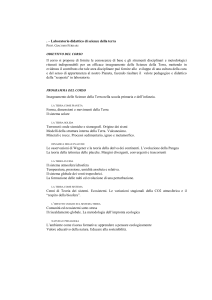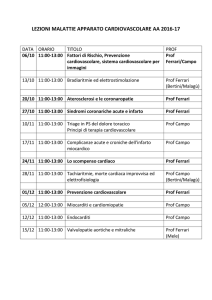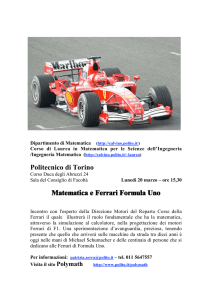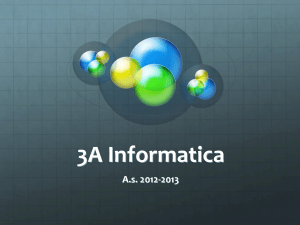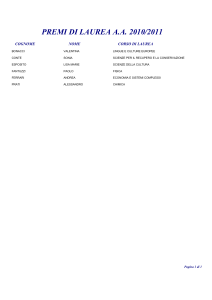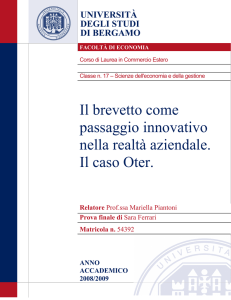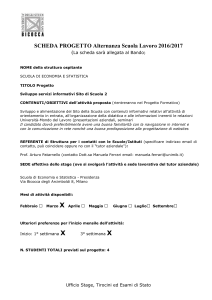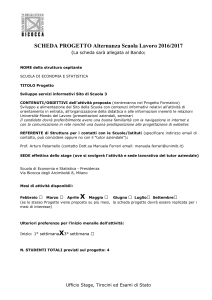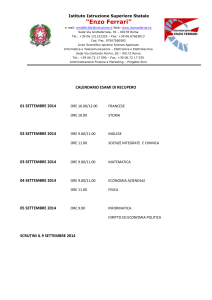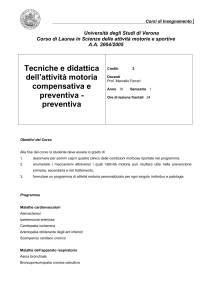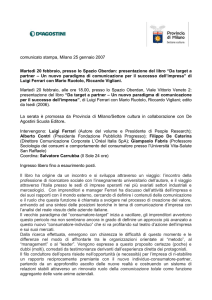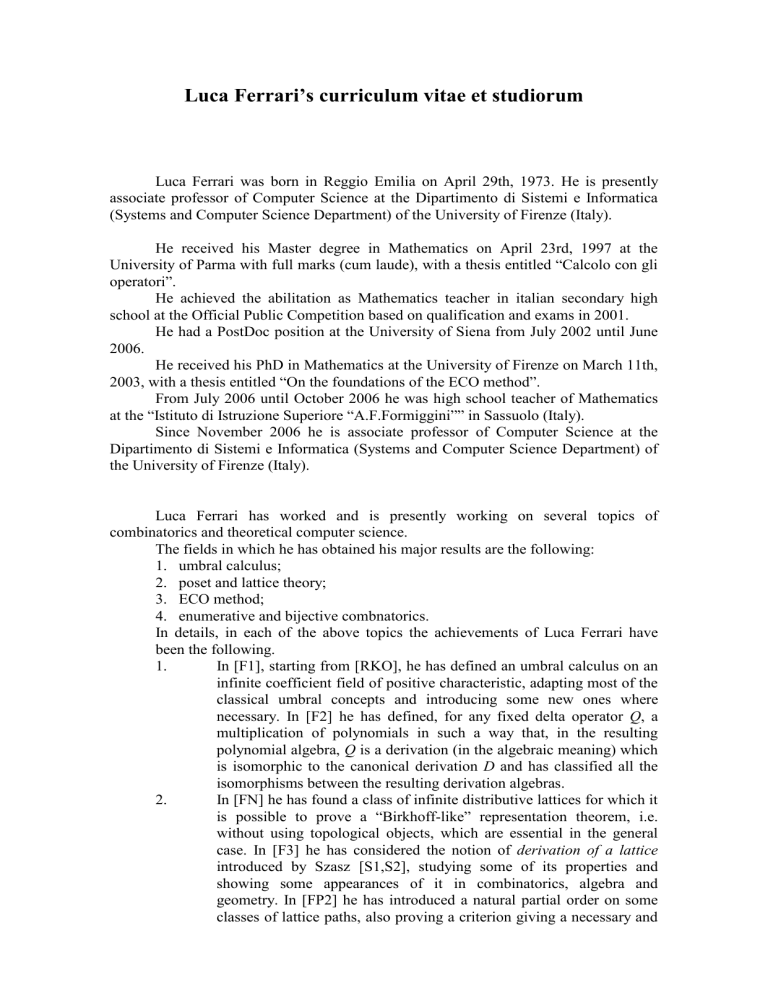
Luca Ferrari’s curriculum vitae et studiorum
Luca Ferrari was born in Reggio Emilia on April 29th, 1973. He is presently
associate professor of Computer Science at the Dipartimento di Sistemi e Informatica
(Systems and Computer Science Department) of the University of Firenze (Italy).
He received his Master degree in Mathematics on April 23rd, 1997 at the
University of Parma with full marks (cum laude), with a thesis entitled “Calcolo con gli
operatori”.
He achieved the abilitation as Mathematics teacher in italian secondary high
school at the Official Public Competition based on qualification and exams in 2001.
He had a PostDoc position at the University of Siena from July 2002 until June
2006.
He received his PhD in Mathematics at the University of Firenze on March 11th,
2003, with a thesis entitled “On the foundations of the ECO method”.
From July 2006 until October 2006 he was high school teacher of Mathematics
at the “Istituto di Istruzione Superiore “A.F.Formiggini”” in Sassuolo (Italy).
Since November 2006 he is associate professor of Computer Science at the
Dipartimento di Sistemi e Informatica (Systems and Computer Science Department) of
the University of Firenze (Italy).
Luca Ferrari has worked and is presently working on several topics of
combinatorics and theoretical computer science.
The fields in which he has obtained his major results are the following:
1. umbral calculus;
2. poset and lattice theory;
3. ECO method;
4. enumerative and bijective combnatorics.
In details, in each of the above topics the achievements of Luca Ferrari have
been the following.
1.
In [F1], starting from [RKO], he has defined an umbral calculus on an
infinite coefficient field of positive characteristic, adapting most of the
classical umbral concepts and introducing some new ones where
necessary. In [F2] he has defined, for any fixed delta operator Q, a
multiplication of polynomials in such a way that, in the resulting
polynomial algebra, Q is a derivation (in the algebraic meaning) which
is isomorphic to the canonical derivation D and has classified all the
isomorphisms between the resulting derivation algebras.
2.
In [FN] he has found a class of infinite distributive lattices for which it
is possible to prove a “Birkhoff-like” representation theorem, i.e.
without using topological objects, which are essential in the general
case. In [F3] he has considered the notion of derivation of a lattice
introduced by Szasz [S1,S2], studying some of its properties and
showing some appearances of it in combinatorics, algebra and
geometry. In [FP2] he has introduced a natural partial order on some
classes of lattice paths, also proving a criterion giving a necessary and
3.
sufficient condition for a poset of lattice paths to be a (finite)
distributive lattice with coordinatewise meet and join; he has then
analyzed the special case of Dyck paths, describing an algorithm which
allows to recursively construct such lattices. We remark that this lattice
structure on Dyck paths plays an important role in algebraic
combinatorics, as shown in [CJ]. In [BBFP] he has shown that the
lattice structure on Dyck paths mentioned above is isomorphic to a
new lattice structure on noncrossing partitions and, more importantly,
to the poset structure induced by the (strong) Bruhat order on 312avoiding permutations (thus proving that Sn(312) is a distributive
lattice). In [BF,F4] an analogous program has been developed starting
from Motzkin, Schröder and Grand-Dyck lattices of paths, thus
obtaining, among other things, interesting distributive lattice structures
on (possibly coloured) permutations avoiding specific sets of patterns.
In [FM] he has deeply analyzed the structure of certain lattices of
paths, namely he has proved some representation theorems and
computed the Euler characteristic (in particular, he has provided a
combinatorial interpretation of the Euler characteristic in the studied
cases).
The ECO method is a methodology developed to count combinatorial
structures by the Discrete Mathematics and Theoretical Computer
Science group of the University of Firenze, under the supervision of
Renzo Pinzani, which is now commonly used in enumerative
combinatorics. Such a method, widely studied in a series of papers
appeared on several international journals (as an example, we cite here
the detailed survey [BDLPP]), allows to effectively and recursively
construct a class of combinatorial objects, by means of a local
expansion technique on the specific objects of the class. In this
context, the research activity of Luca Ferrari is focused on the
mathematical foundations of such a method, a little bit neglected until
now, which surely deserves a deeper insight in view of the remarkable
results obtained by means of the ECO method. The precise aim of the
present research is to describe the ECO method using suitable
mathematical theories. In [FP1] Luca Ferrari has defined the notion of
rule operator as a translation, in linear algebraic notation, of the
concept of succession rule; a rule operator is a linear operator on the
vector space of one-variable polynomials containing all the
enumerative information codified in the associated succession rule. In
[FPPR1], such a notion is used to define an algebra on succession rules
allowing to effectively construct (starting from onr, two or more given
succession rules) a succession rule whose associated numerical
sequence is obtained, from the numerical sequence of the starting
succession rules, by applying simple algebraic operations, such as sum,
convolution product, Hadamard product, and some more; rule
operators happen to be very useful, in particular, as a tool for proving
theorems. In [FPPR2] a generalization of the classical notion of
succession rule is considered: namely, the enumerative properties of
succession rules where each label produces sons at several different
levels (and not only at the successive level, as it happens with classical
succession rules) are studied. The main goal of [DFR1] is to introduce
4.
production matrices, which are the matrix counterpart of rule
operators; the main advantage in using matrices lies in a better
possibility for computation, as well as in the possibility of defining
new interesting operations on succession rules; many examples are
discussed in great detail to support the validity of the production
matrices method.. In [BFP1] the ECO method, together with a special
graphical representation of permutations, has allowed to enumerate all
the classes of permutations avoiding simultaneously three BabsonSteingrimsson patterns (i.e., generalize patterns of type a-bc or ab-c).
In [FP3] the ECO method and the technique of succession rules are
compared with the theory of Catalan-like numbers introduced by
Aigner: namely, it is shown that, in a huge amount of interesting cases,
it is possible to switch from one theory to the other using a suitable
linear transformation; several examples are studied and the cases of
factorial and differential succesion rules are analyzed in detail. In
[DFR2] the production matrices method is used to compare the ECO
method with the theory of (exponential) Riordan arrays and to study in
some detail the case of finite and rational succession rules; a huge
amount of examples is discussed to illustrate the achieved results. In
[FPR1] the theory of integer partitions is described using the ECO
method, and, more precisely, using jumping succession rules; this
appoach has led, among other things, to formulate an interesting
conjecture concerning lecture hall partitions and to enumerate those
partitions whose Ferrers diagram is contained in a generalized hook. In
[FPPR3] some applications of the theory developed in [FP3] are
discussed, aiming at solving problems arising in the framework of the
ECO method by translating them in the language of Aigner matrices
and vice versa; in particular, a bijection between Grand-Dyck paths
starting with an up step and Motzkin paths having bicoloured
horizontal steps (excepts those on the x-axis, which can be tricoloured)
is found, and a combinatorial interpretation for a particularly difficult
Aigner matrix is provided, by using a special class of coloured steep
polyominoes. In [BFP2] the technique used in [BFP1] to deal with
pattern avoiding permutations is modified in order to study pattern
avoiding words; to show the soundness of this approach, some classes
of words simultaneously avoiding two generalized patterns of length
three having at most two distinct letters are enuemerated. In [BFPS]
the study of mixed succession rules initiated in [FPPR2] is continued,
and the case of different succession rule is now considered; more
specifically, the case of succession rules whose rule operators
commute (with respect to the composition operation) is fully
developed.
In [FGPR] Luca Ferrari has provided a combinatorial interpretation for
the even indexed terms of the sequence defined by the recurrence s0=1,
s1=1, sn=2sn-1+sn-2 using the total area under elevated Schröder paths.
In [FR] a direct combinatorial proof of the formula giving the
generating function of integer partitions whose Ferrers diagram is
contained in a generalized hook or in the intersection of two
generalized hooks is provided. More recently, in [DFPR] a
(presumably) new way of interpreting Catalan number is proposed (in
terms of pairs of binary relations), which provides a unification for
many known combinatorial interpretations of such a sequence.
Luca Ferrari is also interested in graph theory with applications to the Web, in
particular PageRank, as well as in some topics of epistemology and history of
mathematics.
Luca Ferrari has been invited speaker at the conference “Algebra e altra
matematica”, held in Siena (Italy) on February 26-27, 2005, with a communication
entitled “On derivations of lattices”.
Other talks of Luca Ferrari have been the following:
“An umbral calculus over infinite coefficient fields of positive characteristic” at
the conference “Umbral Calculus and Applications”, held in Cortona on June 22-27,
1998;
“Polynomial rings in which delta operators are derivations” at the conference
“VI Incontro Italiano di Combinatoria Algebrica”, held in Maratea (Italy) on October 510, 1999;
“A Combinatorial Representation for a Special Class of Complete Distributive
Lattices” at the conference “VII Incontro Italiano di Combinatoria Algebrica”, held in
Prato (Italy) on October 26-28, 2000;
“Jumping Succession Rules and Their Generating Functions” at the conference
“Joint meeting 47^ème Seminaire Lotharingien de Combinatoire - VIII Incontro Italiano
di Combinatoria Algebrica”, held in Bertinoro (Italy) on October 8-10, 2001;
“Lattices of lattice paths” at the conference “Lattice path combinatorics and
discrete distributions”, held in Athens (Greece) on June 5-7, 2002;
“Matrici di produzione” at the conference “IX Incontro Italiano di Combinatoria
Algebrica”, held in Taormina (Italy) on September 22-26, 2002;
“Production matrices” at the conference “Formal Power Series and Algebraic
Combinatorics”, held in Vadstena (Sweden) on June 23-27, 2003;
“Catalan-like numbers and succession rules” at the conference “Paths,
Permutations and Trees”, held in Tianjin (Cina) on February 25-27, 2004;
“Enumerative problems and results on integer partitions using the ECO method”
at the conference “International Colloquium of Mathematics and Computer Science”,
held in Wien (Austria) on September 13-17, 2004;
“Some order-theoretic properties of the Motzkin and Schröder families” at the
conference “Permutation Patterns 2006”, held in Reykjavik (Iceland) on June 12-16,
2006;
“Enumeration of some classes of words avoiding two generalized patterns of
length three” at the conference “Permutation Patterns 2007”, held in St. Andrews
(Scotland) on June 11-15, 2007;
“The Euler characteristic of some lattices of paths” at the conference “Lattice
Path Combinatorics and Applications”, held in Johnson City, TN (USA) on July 12-14,
2007.
“Mixed succession rules: the commutative case” at the conference “Fibonacci
Numbers and their Applications”, held in Patras (Greece) on July 13-17, 2008.
“Some combinatorics related to central binomial coefficients: Grand-Dyck paths,
coloured noncrossing partitions and signed pattern avoiding permutations” at the
conference “CANADAM 2009 - The 2nd Canadian Discrete and Algorithmic
Mathematics Conference”, held in Montreal (Canada) on May 25-28, 2009.
Luca Ferrari has also presented the following posters:
“Some bijective results about the area of Schröder paths” at the conference
“GASCom 2001 and Bijective Combinatorics”, held in Pontignano (Italy) on November
18-20, 2001.
“A distributive lattice structure on noncrossing partitions” at the conference
“Formal Power Series and Algebraic Combinatorics”, held in Taormina (Italy) on June
20-26, 2005.
Luca Ferrari has also attended the following conferences:
summer course of Combinatorial Geometry, held in Cortona (Italy), from June,
29 to July, 11, 1998,
summer school of Combinatorial Geometry “Giuseppe Tallini”, held in S. Felice
del Benaco (Italy) on September 6-12, 1998,
“V Incontro Italiano di Combinatoria Algebrica”, held in Prato (Italy) on
November 12-14, 1998,
“SUNLAG 2000”, held in Caserta (Italy) on March 21-24, 2000,
“CATOP2000”, held in Fribourg (Switzerland) on July 4-6, 2000,
“46^ème Seminaire Lotharingien de Combinatoire”, held in Lyon (France) on
March 19-21, 2001,
“Formal Power Series and Algebraic Combinatorics”, held in Phoenix (USA) on
May 21-25, 2001,
“Gian-Carlo Rota Memorial Conference”, held in Barisciano (Italy) on April 2527, 2002,
“Joint meeting 51^ème Seminaire Lotharingien de Combinatoire – X Incontro
Italiano di Combinatoria Algebrica”, held in Bertinoro (Italy) on September 22-24,
2003,
“Secondo Convegno Italiano di Teoria dei Numeri”, held in Parma (Italy) on
November 13-15, 2003,
“XI Incontro Italiano di Combinatoria Algebrica”, held in Maratea (Italy) on
September 26-30, 2004,
“54^ème Seminaire Lotharingien de Combinatoire”, held in Lucelle (France) on
April 4-6, 2005,
“Joint meeting 55^ème Seminaire Lotharingien de Combinatoire – XII Incontro
Italiano di Combinatoria Algebrica”, held in Bertinoro (Italy) on September 26-28,
2005,
“XIII Incontro Italiano di Combinatoria Algebrica”, held in Roma (Italy) on
December 18-20, 2006.
“Joint meeting 59^ème Seminaire Lotharingien de Combinatoire – XIV Incontro
Italiano di Combinatoria Algebrica”, held in Bertinoro (Italy) on September 24-26,
2007.
“Gascom 2008”, held in Bibbiena (Italy) on June 16-19, 2008.
“Algebra e Informatica Teorica”, held in Siena (Italy) on September 22, 2008.
“Permutation Patterns 2009”, held in Firenze (Italy) on July 13-17, 2009.
“Eurocomb 2009”, held in Bordeaux (France) on September 7-11, 2009.
He is member of the Editorial Board of the journals “The Open Mathematics
Journal” and “Pure Mathematics and Applications” (section “Algebra and Theoretical
Computer Science”).
He is member of the scientific and organizing commitees of the international
conference “Permutation Patterns 2010”, to be held in Dartmouth (USA) on August 913, 2010. He is member of the organizing committee of the international conference
“Lattice Path Combinatorics and Applications”, to be held in Siena (Italy) on July 4-7,
2010.
He has been member of the organizing and scientific committee of the
international conference “Permutation Patterns 2009”, held in Firenze (Italy) on July 1317, 2009. He has been member of the organizing committee of the international
conferences “GASCom 2001 and Bijective Combinatorics”, held in Pontignano (Italy)
on November 18-20, 2001 and “GASCom 2008”, held in Bibbiena (Italy) on June 1619, 2008.
He has been referee for the journals “Discrete Mathematics”, “Journal of Integer
Sequences”, “Linear Algebra and Its Applications”, “Pure Mathematics and
Applications”, “Theoretical Computer Science”.
He is a reviewer of “Mathematical Reviews”.
He is member of the committee of the PhD Program in “Ingegneria Informatica e
dell’Automazione” (“Computer Science and Automatic Engineering”) of the University
of Firenze (Italy).
He has been member of the National (Italian) Research Project “Linguaggi
Formali e Automi: Teoria e Applicazioni”, in 2002-2003.
He has been member of the National (Italian) Research Project “Linguaggi
Formali e Automi: Metodi, Modelli e Applicazioni”, in 2004-2005.
He has been member of the National (Italian) Research Project “Automi e
Linguaggi Formali: Aspetti Matematici e Applicativi”, in 2006-2007.
He is member of the National (Italian) Research Project “Aspetti matematici e
applicazioni emergenti degli automi e dei linguaggi formali” in 2009-2010.
References
[BFPS] S. Bacchelli, L. Ferrari, R. Pinzani, R. Sprugnoli, Mixed successsion
rules: the commutative case, Journal of Combinatorial Theory, Series A, to appear.
[BBFP] E. Barcucci, A. Bernini, L. Ferrari, M. Poneti, A distributive lattice
structure connecting Dyck paths, noncrossing partitions and 312-avoiding
permutations, Order, 22 (2005) 311-328.
[BDLPP]
E. Barcucci, A. Del Lungo, E. Pergola, R. Pinzani,
ECO: A
methodology for the Enumeration of Combinatorial Objects, Journal of Difference
Equations and Applications, 5 (1999) 435-490.
[BF] A. Bernini, L. Ferrari, Some order-theoretic properties of the Motzkin
and Schröder families, Australasian Journal of Combinatorics, 39 (2007) 259-272.
[BFP1] A. Bernini, L. Ferrari, R. Pinzani, Enumerating permutations avoiding
three Babson-Steingrimsson patterns, Annals of Combinatorics, 9 (2005) 137-162.
[BFP2] A. Bernini, R. Pinzani, L. Ferrari, Enumeration of some classes of
words avoiding two generalized patterns of length three,
Journal of Automata,
Languages and Combinatorics, to appear.
[CJ]
S. Cautis, D. M. Jackson,
The matrix of chromatic joins and the
Temperley-Lieb algebra, Journal of Combinatorial Theory Series B, 89 (2003) 109155.
[DFR1] E. Deutsch, L. Ferrari, S. Rinaldi, Production matrices, Advances in
Applied Mathematics, 34 (2005) 101-122.
[DFR2] E. Deutsch, L. Ferrari, S. Rinaldi, Riordan arrays and production
matrices, Annals of Combinatorics, 13 (2009) 65-85.
[DFPR] F. Disanto, L. Ferrari, R. Pinzani, S. Rinaldi, Catalan numbers and
relations, submitted.
[F1] L. Ferrari, An umbral calculus over infinite coefficient fields of positive
characteristic, Computer and Mathematics with Applications, 41 (2001) 1099-1108.
[F2] L. Ferrari, Polynomial rings in which delta operators are derivations,
European Journal of Combinatorics, 22 (2001) 1059-1064.
[F3]
L. Ferrari,
On derivations of lattices,
Pure Mathematics and
Applications, 12 (2001) 365-382.
[FGPR] L. Ferrari, E. Grazzini, E. Pergola, S. Rinaldi, Some bijective results
about the area of Schröder paths, Theoretical Computer Science, 307 (2003) 327335.
[FM] L. Ferrari, E. Munarini, Lattices of paths: representation theory and
valuations, submitted.
[FN] L. Ferrari, G. Nicoletti, A combinatorial representation for a special
class of complete distributive lattices, Annals of Combinatorics, 5 (2001) 285-304.
[FP1] L. Ferrari, R. Pinzani, A linear operator approach to succession rules,
Linear Algebra and its Applications, 348 (2002) 231-246.
[FP2] L. Ferrari, R. Pinzani, Lattices of lattice paths, Journal of Statistical
Planning and Inference, 135 (2005) 77-92.
[FP3] L. Ferrari, R. Pinzani, Catalan-like numbers and succession rules,
Pure Mathematics and Applications, 16 (2005) 229-250.
[F4] L. Ferrari, Some combinatorics related to central binomial coefficients:
Grand-Dyck paths, coloured noncrossing partitions and signed pattern avoiding
permutations, Graphs and Combinatorics, to appear.
[FPR] L. Ferrari, R. Pinzani, S. Rinaldi, Enumerative results and problems on
integer partitions using the ECO method, Mathematics and computer science, III
(Wien, 2004), Trends Math., Birkhäuser, Basel, pp. 25-36 .
[FPPR1]
L. Ferrari, E. Pergola, R. Pinzani, S. Rinaldi,
An algebraic
characterization of the set of succession rules, Theoretical Computer Science, 281
(2002) 351-367.
[FPPR2] L. Ferrari, E. Pergola, R. Pinzani, S. Rinaldi, Jumping succession
rules and their generating functions, Discrete Mathematics, 271 (2003) 29-50.
[FPPR3] L. Ferrari, E. Pergola, R. Pinzani, S. Rinaldi, Some applications
arising from the interactions between the theory of Catalan-like numbers and the ECO
method, Ars Combinatoria, to appear.
[FR] L. Ferrari, S. Rinaldi, Enumeration of generalized hook partitions,
Integers, 5 (2005) #A29 (7 pp.).
[RKO] G.-C. Rota, D. Kahaner, A. Odlyzko, Finite Operator Calculus,
Academic Press, New York, 1975.
[S1]
G. Szasz,
Translationen der verbände,
Acta Facultatis Rerum
Naturalium Universitatis Comenianae, 5 (1961) 53-57.
[S2] G. Szasz, Derivations of lattices, Acta Scientiarum Mathematicarum
(Szeged), 37 (1975) 149-154.

